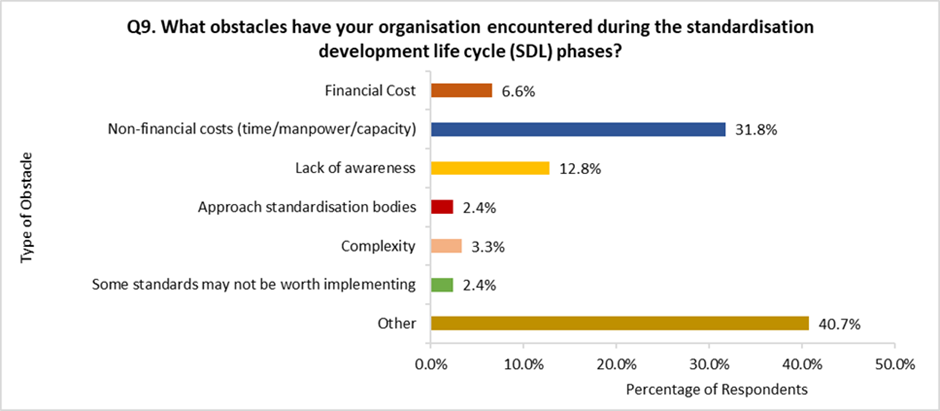STAND4EU Obstacles
During the first phase of the project, STAND4EU focused on having a good understanding
about the current bottlenecks, barriers and obstacles that hamper or prevent the
development and uptake of standardisation efforts.
The main bottlenecks identified were:
- Lack of resources and funding
- Lack of time
- Poor quality of a standard
- Lack of expertise
- Low coordination and lack of processes
- Complexity of a process and bureaucracy
- Complexity of scope and landscape
- Poor involvement of experts
- Low motivation and interest
- Poor transferability, low support and missing education propositions
- Low development speed
- Lack of consensus and conflict of interests
Below are presented some information and graphics extracted from the conducted survey, interviews and trend analysis workshops:
Our results show that the major obstacles identified are a lack of awareness
about the right standard(s) to be used, apart from financial costs,
non-financial costs like time, labour and capacity required to implement
standards, and the complexity of standards.

Our interview results also show that beyond financial and non-financial
costs (time/manpower/capacity), there are multiple other obstacles
identified by respondents.
Some of these concern the amount of comments in
standardisation reports, keeping track of what is published, a lack of
access to all standards, making dialogue with other companies, gaining
support from the community, getting a consensus during the voting process,
the difficulty of developing a standard in a language they are not native
in, finding the correct project leader, and the lack of marketing.

Our top suggestions to improve standardisation from our interviews include
funding increases, time reductions, and other, more specific recommendation.
Some of these are developing standards to motivate consumers to use a
product, publishing standards in a minimum viable form and updating them
later, making a platform to find standards easier, avoiding duplication of
work through information-sharing across projects, aligning standards with
values of the civil society, creating a body to write routine reports on
standardisation, and creating machine-readable systemic standards.
